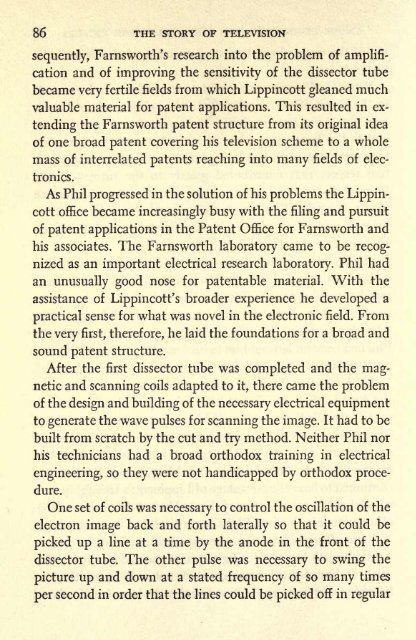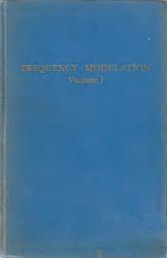the life of Philo T Farnsworth - Early Television Foundation
the life of Philo T Farnsworth - Early Television Foundation
the life of Philo T Farnsworth - Early Television Foundation
You also want an ePaper? Increase the reach of your titles
YUMPU automatically turns print PDFs into web optimized ePapers that Google loves.
86 THE STORY OF TELEVISION<br />
sequently, <strong>Farnsworth</strong>'s research into <strong>the</strong> problem <strong>of</strong> amplification<br />
and <strong>of</strong> improving <strong>the</strong> sensitivity <strong>of</strong> <strong>the</strong> dissector tube<br />
became very fertile fields from which Lippincott gleaned much<br />
valuable material for patent applications. This resulted in extending<br />
<strong>the</strong> <strong>Farnsworth</strong> patent structure from its original idea<br />
<strong>of</strong> one broad patent covering his television scheme to a whole<br />
mass <strong>of</strong> interrelated patents reaching into many<br />
fields <strong>of</strong> electronics.<br />
As Phil progressed<br />
in <strong>the</strong> solution <strong>of</strong> his problems <strong>the</strong> Lippincott<br />
<strong>of</strong>fice became increasingly busy with <strong>the</strong> filing<br />
and pursuit<br />
<strong>of</strong> patent applications<br />
in <strong>the</strong> Patent Office for <strong>Farnsworth</strong> and<br />
his associates. The <strong>Farnsworth</strong> laboratory came to be recognized<br />
as an important electrical research laboratory. Phil had<br />
an unusually good nose for patentable material. With <strong>the</strong><br />
assistance <strong>of</strong> Lippincott's broader experience he developed a<br />
practical sense for what was novel in <strong>the</strong> electronic field. From<br />
<strong>the</strong> very first, <strong>the</strong>refore, he laid <strong>the</strong> foundations for a broad and<br />
sound patent structure.<br />
After <strong>the</strong> first<br />
dissector tube was completed and <strong>the</strong> magnetic<br />
and scanning coils adapted to it, <strong>the</strong>re came <strong>the</strong> problem<br />
<strong>of</strong> <strong>the</strong> design and building <strong>of</strong> <strong>the</strong> necessary electrical equipment<br />
to generate <strong>the</strong> wave pulses for scanning <strong>the</strong> image. It had to be<br />
built from scratch by <strong>the</strong> cut and try method. Nei<strong>the</strong>r Phil nor<br />
his technicians had a broad orthodox training in electrical<br />
engineering, so <strong>the</strong>y were not handicapped by orthodox procedure.<br />
One set <strong>of</strong> coils was necessary to control <strong>the</strong> oscillation <strong>of</strong> <strong>the</strong><br />
electron image back and forth laterally so that it could be<br />
picked up a line at a time by <strong>the</strong> anode in <strong>the</strong> front <strong>of</strong> <strong>the</strong><br />
dissector tube. The o<strong>the</strong>r pulse was necessary to swing <strong>the</strong><br />
picture up and down at a stated frequency <strong>of</strong> so many times<br />
per second in order that <strong>the</strong> lines could be picked <strong>of</strong>f in regular











